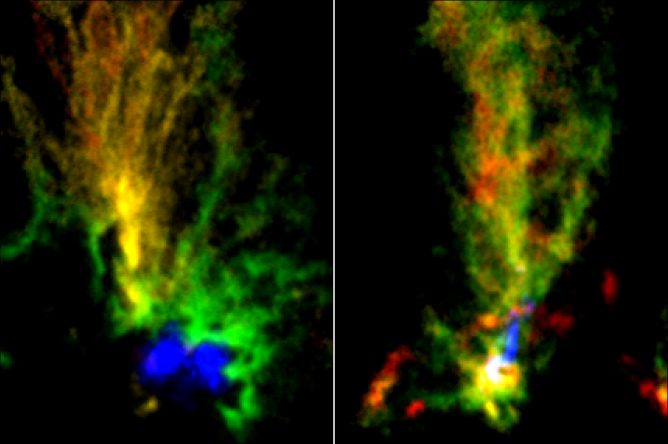ALMA | NAOJ | NRAO | ESO | 2019 Nov 14
Two peacock-shaped gas clouds were revealed in the Large Magellanic Cloud (LMC) by observations with the Atacama Large Millimeter / submillimeter Array (ALMA). A team of astronomers found several massive baby stars in the complex filamentary clouds, which agrees well with computer simulations of giant collisions of gas clouds. The researchers interpret this to mean that the filaments and young stars are telltale evidence of violent interactions between the LMC and the Small Magellanic Cloud (SMC) 200 million years ago.
- ALMA images of two molecular clouds: N159E-Papillon Nebula (left) and N159W South (right). Red and green show the distributions of molecular gas with different velocities mapped by 13CO emissions. The blue region in N159E-Papillon Nebula shows the ionized hydrogen gas observed with the Hubble Space Telescope. The blue part in N159W South shows the emissions from dust particles obtained with ALMA. Credit: ALMA (ESO/NAOJ/NRAO)/Fukui et al./Tokuda et al./NASA-ESA Hubble
Astronomers know that stars are formed in collapsing clouds in space. However, the formation processes of giant stars, 10 times or more massive than the Sun, are not well understood because it is difficult to pack such a large amount of material into a small region. Some researchers suggest that interactions between galaxies provide a perfect environment for massive star formation. Due to the colossal gravity, clouds in the galaxies are stirred, stretched, and often collide with each other. A huge amount of gas is compressed in an unusually small area, which could form the seeds of massive stars.
A research team used ALMA to study the structure of dense gas in N159, a bustling star formation region in the LMC. Thanks to ALMA’s high resolution, the team obtained a very detailed map of the clouds in two sub-regions, N159E-Papillon Nebula and N159W South.
Interestingly, the cloud structures in the two regions look very similar: fan-shaped filaments of gas extending to the north with the pivots in the southernmost points. The ALMA observations also found several massive baby stars in the filaments in the two regions. ...
An ALMA View of Molecular Filaments in the Large Magellanic Cloud. I. The Formation of
High-Mass Stars and Pillars in the N159E-Papillon Nebula Triggered by a Cloud–Cloud Collision ~ Yasuo Fukui et al
- Astrophysical Journal 886(1):14 (20 Nov 2019) DOI: 10.3847/1538-4357/ab4900
- arXiv.org > astro-ph > arXiv:1811.00812 > 02 Nov 2018 (v1), 13 Nov 2019 (v5)
of High-mass Star Formation Embedded at Colliding Clouds in N159W-South ~ Kazuki Tokuda et al
- Astrophysical Journal 886(1):15 (20 Nov 2019) DOI: 10.3847/1538-4357/ab48ff
- arXiv.org > astro-ph > arXiv:1811.04400 > 11 Nov 2018 (v1), 13 Nov 2019 (v4)
